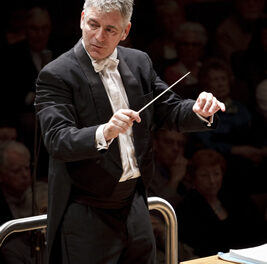The Western Piedmont Symphony concluded its current season with a Masterworks concert in the P. E. Monroe Auditorium of Lenoir-Rhyne University. The Hyperion String Quartet, based in Saratoga Springs, NY, was the guest Quartet-in-Residence for this concert and is the last to audition for the three-year term which begins in the fall.
Opening the program was Overture to Semiramide by Gioacchino Rossini (1792-1868). Semiramide was the last opera Rossini wrote for the Italian stage. Thereafter, he worked in Paris. It was also one of the first to use themes from the opera itself in the overture. There is a wonderful quartet for French horns early in the work, played superbly by the orchestra’s horn section, and numerous piccolo solos, played with great facility and beauty by Lissie Okopny.
Completing the first half of the concert was the second world premiere performance of Orfei Mors (The Death of Orpheus), a concerto for cello and orchestra by Armando Bayolo (born 1973). The first performance was given on March 11th by The Society for New Music in Syracuse, NY. Both performances featured Philip von Maltzahn, for whom the piece was written, as the cello soloist. The work was commissioned jointly by the Western Piedmont Symphony and the Society for New Music, and supported by numerous Arts Council and Grassroots grants. Mr. Bayolo is a native of Puerto Rico, and has a long list of successful compositions. He is also a very active conductor.
Mr. von Maltzahn is former Principal Cellist of the Western Piedmont Symphony and a member of the Degas Quartet. He is currently also Assistant Principal Cello of the Greensboro Symphony.
As one would expect from the title, this is a somewhat dark piece. It is in two movements, but played without interruption. Also, it is not terribly tonal or melodic, but certainly paints the picture well of Orpheus’ anguish at losing his love, Eurydice, and his own death. There is no doubt about the descent into Hades, with the great foreboding clanging of the percussion. The solo work of Mr. von Maltzahn, from the opening cadenza to the final intonation of the same theme, was stunning and riveting, expressing the anguish and love of Orpheus for Eurydice. The orchestral performance was, likewise, impressive. Because of the complexity of works such as this, it is difficult to fully appreciate them with just one hearing. Hopefully, there will be other opportunities to audition this piece.
Closing the concert, and thus the season, was Variations on an Original Theme “Enigma,” Op. 36, by Sir Edward Elgar (1857-1934). Elgar was Britain’s first composer to achieve international stature in almost two centuries, and it was his “Enigma” Variations that would earn him this reputation.
The piece consists of a theme and fourteen variations. The “enigma” is the source of the theme, a secret never revealed by Elgar. Each of the first thirteen variations represents one of the composer’s friends, and the fourteenth is a self-portrait. In performing this work, the orchestra has seldom sounded better, with the strings lush and broad, the woodwinds joyful and playful, the brass triumphant, and the tympani and percussion assertive, all painting an exquisite portrait of Elgar and his circle of friends.











